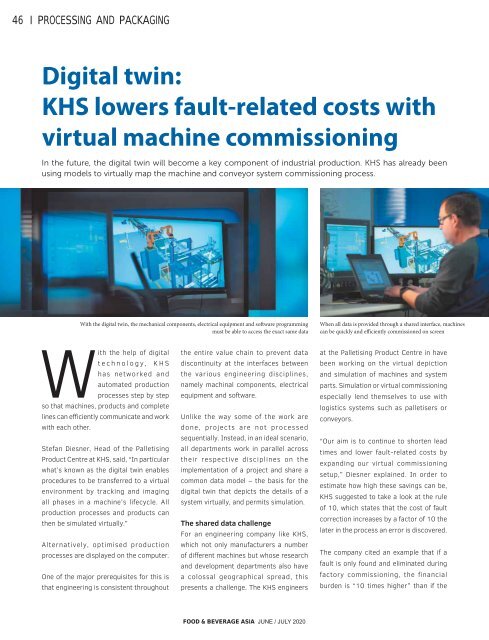Food & Beverage Asia June/July 2020
Food & Beverage Asia (FBA) is the leading source of food and beverage news in Asia since 2002. FBA delivers a comprehensive view of the food and beverage landscape, spanning across the latest health and nutrition trends and industry innovations in ingredients, recipe formulations, food science, sustainability, packaging, and automation, as well as advancements in agri and food-tech.
Food & Beverage Asia (FBA) is the leading source of food and beverage news in Asia since 2002. FBA delivers a comprehensive view of the food and beverage landscape, spanning across the latest health and nutrition trends and industry innovations in ingredients, recipe formulations, food science, sustainability, packaging, and automation, as well as advancements in agri and food-tech.
Create successful ePaper yourself
Turn your PDF publications into a flip-book with our unique Google optimized e-Paper software.
46<br />
PROCESSING AND PACKAGING<br />
Digital twin:<br />
KHS lowers fault-related costs with<br />
virtual machine commissioning<br />
In the future, the digital twin will become a key component of industrial production. KHS has already been<br />
using models to virtually map the machine and conveyor system commissioning process.<br />
With the digital twin, the mechanical components, electrical equipment and software programming<br />
must be able to access the exact same data<br />
When all data is provided through a shared interface, machines<br />
can be quickly and efficiently commissioned on screen<br />
With the help of digital<br />
technology, KHS<br />
has networked and<br />
automated production<br />
processes step by step<br />
so that machines, products and complete<br />
lines can efficiently communicate and work<br />
with each other.<br />
Stefan Diesner, Head of the Palletising<br />
Product Centre at KHS, said, “In particular<br />
what’s known as the digital twin enables<br />
procedures to be transferred to a virtual<br />
environment by tracking and imaging<br />
all phases in a machine’s lifecycle. All<br />
production processes and products can<br />
then be simulated virtually.”<br />
Alternatively, optimised production<br />
processes are displayed on the computer.<br />
One of the major prerequisites for this is<br />
that engineering is consistent throughout<br />
the entire value chain to prevent data<br />
discontinuity at the interfaces between<br />
the various engineering disciplines,<br />
namely machinal components, electrical<br />
equipment and software.<br />
Unlike the way some of the work are<br />
done, projects are not processed<br />
sequentially. Instead, in an ideal scenario,<br />
all departments work in parallel across<br />
their respective disciplines on the<br />
implementation of a project and share a<br />
common data model – the basis for the<br />
digital twin that depicts the details of a<br />
system virtually, and permits simulation.<br />
The shared data challenge<br />
For an engineering company like KHS,<br />
which not only manufacturers a number<br />
of different machines but whose research<br />
and development departments also have<br />
a colossal geographical spread, this<br />
presents a challenge. The KHS engineers<br />
at the Palletising Product Centre in have<br />
been working on the virtual depiction<br />
and simulation of machines and system<br />
parts. Simulation or virtual commissioning<br />
especially lend themselves to use with<br />
logistics systems such as palletisers or<br />
conveyors.<br />
“Our aim is to continue to shorten lead<br />
times and lower fault-related costs by<br />
expanding our virtual commissioning<br />
setup,” Diesner explained. In order to<br />
estimate how high these savings can be,<br />
KHS suggested to take a look at the rule<br />
of 10, which states that the cost of fault<br />
correction increases by a factor of 10 the<br />
later in the process an error is discovered.<br />
The company cited an example that if a<br />
fault is only found and eliminated during<br />
factory commissioning, the financial<br />
burden is “10 times higher” than if the<br />
FOOD & BEVERAGE ASIA JUNE / JULY <strong>2020</strong>


















